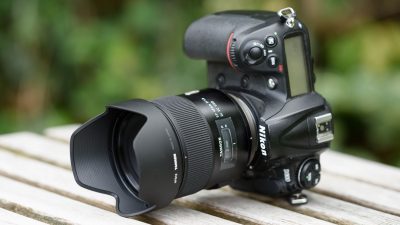Tamron 45mm f1.8 VC review
-
-
Written by Thomas
In depth
The Tamron SP 45mm f/1.8 Di VC USD is a full-frame standard lens available in Canon, Nikon, and Sony mounts. It was announced in August 2015 together with its shorter sibling, the Tamron SP 35mm f/1.8 Di VC USD. These lenses are some of the few stabilized short primes on the market. Introducing stabilized primes with focal lengths below 100mm is an important move that reflects the development of ever-higher mega pixel count sensors. With 36MP, 42MP and 50MP full-frame sensors as well as 24MP APS-C/DX sensors it is increasingly hard to achieve really sharp shots devoid of (micro-)blur. The old 1/focal-length rule for shutter-speeds that are on the safe side no longer applies for the pixel-densities of modern sensors: today we’re more talking about using 1/100 sec on a standard lens of 45-58mm focal length. But with the image stabilization (dubbed “Vibration Control”/VC) introduced by Tamron for its 35mm and 45mm primes there’s hope to get sharp shots hand-held at around 1/10 sec. Which would be a boon in situations of low available light or when you have to stop down to get enough depth of field. But the introduction of stabilization means that the optical design has to change and additional lens elements need to be introduced. Would this compromise image quality?
To find out I tested the Tamron SP 45mm f/1.8 VC alongside the Tamron SP 35mm f/1.8 VC (see my Tamron 35/1.8 VC review) and compare the results against Nikon’s own AF-S 50mm f/1.4G and the Sigma 50mm f/1.4 “Art”.
PS – don’t forget you can support my work next time you order anything at Amazon, B&H or Adorama by first clicking through to them using the links above and in the sidebar. It works for anything you order at any time – thanks for your support!
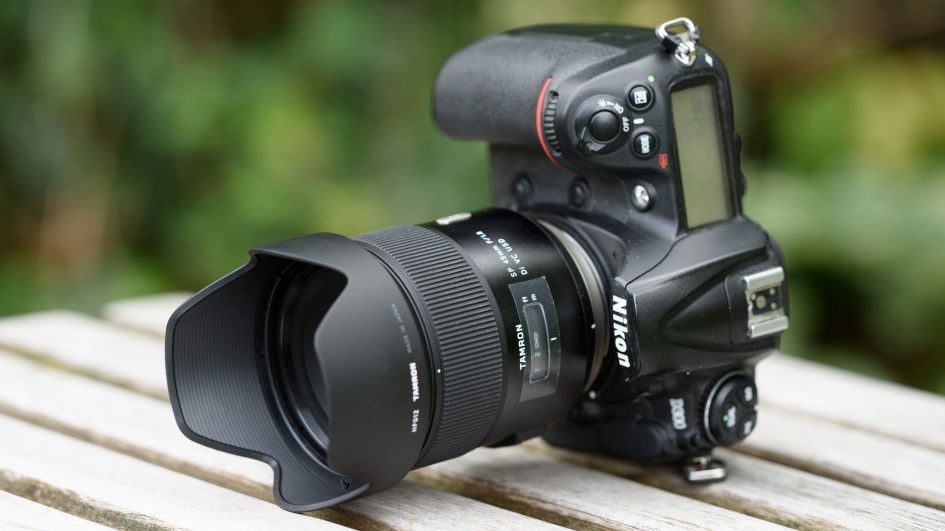
Facts from the catalog
As usual I’ll have a look at the technical data first. I’ve rated the features with a [+] (or [++]), when it’s better than average or even state of the art, a [0] if it’s standard or just average, and [-] if there’s a disadvantage. I’ll compare it with the Sigma Art AF 50mm 1.4 DG HSM (the “Sigma 50/1.4” for short).
Size (diam. x length): 80 x 89mm (3.1 x 3.5in). Not exactly a small lens. But the Sigma 50/1.4 is even bigger at 85 x 100mm. [0]
Weight: 520g (18.3 oz). This is lighter than the Sigma 50/1.4 which comes in at 815g. [+]
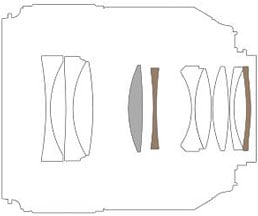
Optics: 10 elements in 8 groups. This is less than the Sigma 50/1.4 with 13 elements in 8 groups although the Tamron features image stabilization. The lens design includes one low dispersion elements, two molded glass aspherical elements, and coating with a nano-structured layer. [+]
Closest focus distance/max. magnification: 0.29m (11.4in) / 1:3.4. That is a pretty good value for people trying to capture small subjects. Although the working distance between the front element and the subject is only 15cm at maximum magnification. The Sigma 50/1.4 reaches 1:5.6 at 0.4m. [+]
Filter-thread: 67mm. Those filters are cheaper than the professional standard 77mm filters, but you may have to get new ones. The Sigma uses 77mm. [0]
Image Stabilization: Yes – except when you buy the Sony version! The Sigma has none. [+]
Auto Focus: USD (Ultrasonic Silent Drive), so it does also work on bodies that don’t have a built-in AF drive like the Nikon D3x00/5×00. Manual-focus override is by simply turning the focus ring. Same with the competition. [+]
Covers full frame/FX or smaller = very good. Same with the competition. [+]
Price: around 760 EUR new (incl. 19% VAT), the Sigma 50/1.4 can be had for 750 EUR. [0]
Comes with no case but the lens hood is included and reversible for transport, the lens caps are are similar to Nikon’s pincer-type. The Sigma comes with a nicer well-padded case. [-]
Distance information is relayed to the camera, so the Nikon body can do all the advanced exposure-related stuff with this lens. Same with the competition. [+]
Aperture ring: no. Same as with all the other alternatives. [0]
Sealing: A rubber grommet at the lens-mount. [+]
The score in the “features-department” is 1[-]/4[0]/8[+]. In direct comparison to the Sigma 50/1.4 Art the new Tamron 45/1.8 VC has three advantages: It is stabilized, it offers a 1:3.4 magnification, and it’s 300g lighter. But then you give up the build quality of the Sigma and two-thirds of a stop of maximum aperture (f1.8 vs. f1.4). The other minus-point of the Tamron on paper is the missing lens-case. Why Tamron decided to deliver a 700+ EUR lens without one is beyond me.
Alternative standard lenses for full-frame bodies
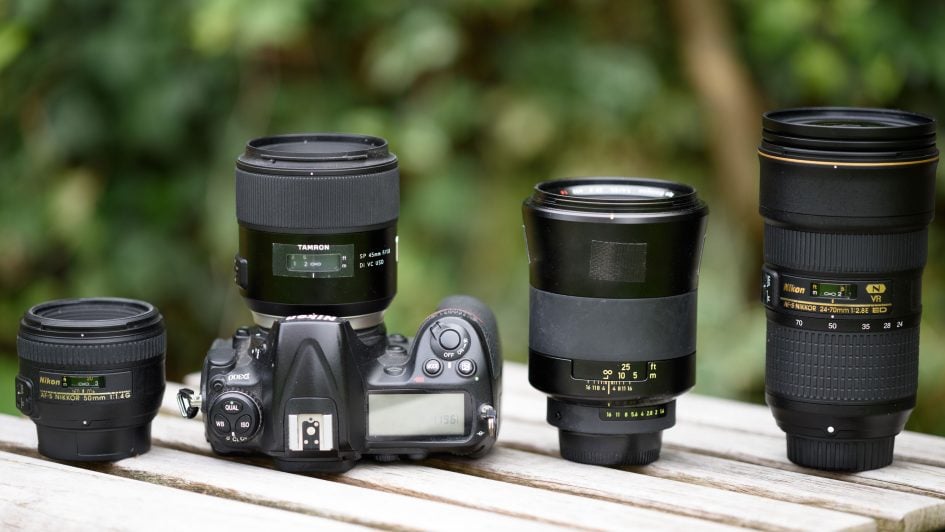
Above from left to right: Nikon 50/1.4G, Tamron 45/1.8 VC, Zeiss 55/1.4 Otus, Nikon 24-70/2.8E VR
Alternatives:
– Nikon offers the AF-S Nikkor 50/1.8G ED. It’s not stabilized and costs around 170 EUR. It earned a Recommended in my Nikon 50/1.8G review.
– For Canon full-frame bodies there is the non-stabilized EF 50/1.8 STM which can be had for less than 120 EUR. See Gordon’s Canon EF 50mm f1.8 STM review.
– If you don’t mind getting a bigger glass you might as well look for 50/1.4 lenses where the prime alternative is Sigma’s 50/1.4 Art that sells for about the same price as the Tamron and performed convincingly (see my Sigma 50/1.4 Art review). Then there is Nikon’s own 50/1.4G (see my Nikon 50/1.4G review) at 320 EUR. Canon offers the EF 50mm 1.4 USM at around 300 EUR. All those primes are not stabilized but offer a 2/3 faster aperture. Unless you go for the Canon 50/1.2L USM which offers a 1.2 stops faster aperture and can be had for around 1200 EUR (see Gordon’s Canon EF 50mm f1.2L USM review). And finally there are some manual focus alternatives from Samyang/Walimex and Zeiss – all without stabilization. Optically the best in this group of manual focus standard lenses certainly is the Zeiss Otus 55mm f1.4 which is also the most expensive at 3500 EUR (see my Zeiss Otus 55/1.4 review).
– Or you go for a bright standard full-frame zoom that covers 45mm and gives you the flexibility to cover more shooting opportunities due to their variable focal length. There are only two stabilized f/2.8 zoom: The Tamron SP AF 24-70mm f2.8 Di VC USD (800 EUR, see my Tamron 24-70/2.8 VC review) and Nikon’s new AF-S VR 24-70mm f2.8E ED. But that is the most expensive alternative at 2500 EUR (see my Nikon 24-70/2.8E VR review).
Focus and image stabilization
Focus accuracy and repeatability is critical to consistently produce sharp shots. Repeatability (the accuracy of focus on the same subject after repeated focus-acquisition) of this lens is very good (measured 98,9% in FoCal) with no outliers over a series of 40 shots. And there is little performance variation whether the lens focuses from infinity or from a closer distance. Unfortunately Tamron Europe had to exchange the first lens for a second copy for the AF to work properly. And the second copy was still finicky to find the right fine-tune value for AF.
The lens focuses in around 0.7 sec from infinity to 0.45m which is not bad. The 25mm broad focus ring has no slack/play between its movement and the focus-action and movement is of medium smoothness. It has a long throw of 185 degrees which makes manual focusing at large apertures easy. It turns the same way as Canon photogs are used to but that is the wrong way for Nikon users. AF-operation is barely audible from the outside. If you record video with the built-in microphone every focus-movement starts with only a slight “clack” and the AF-drive is very quiet. The VR-system is virtually silent both on the outside and when recording video.
To test the effectiveness of the image stabilization I did a series of 100 test-shots hand-held. Shutter speeds were from 1/40 of a second down to 1/5 sec. Comparing the shots with VC=ON with a reference sample of 20 shots at 1/40 sec with VC=OFF I can report that the VR is good for 2 to 3 stops of image-stabilization. That is a good result and a main benefit compared to non-stabilized primes. It means you can shoot at 1/10 sec and still get a very high keeper-rate. Even at 1/5 sec you still have a hit-rate of around 50%.
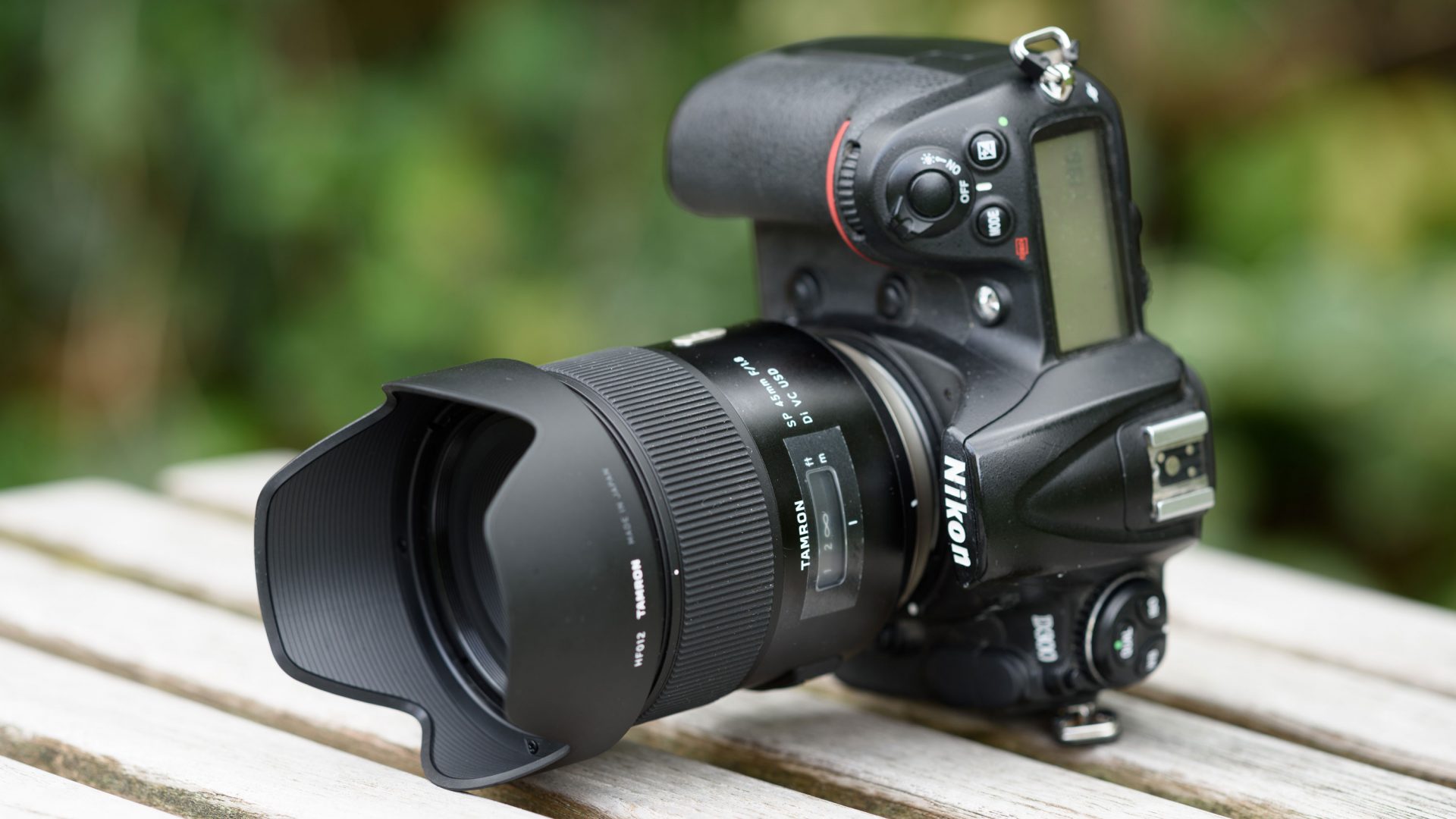
 The new Tamron 45/1.8 VC is a very versatile and interesting lens: It offers a fast f/1.8 aperture combined with image-stabilization that is good for two stops in my tests. Both allow the lens to hold out longer in dimly lit situations. It produces very sharp images with very little coma right into the corner of a full-frame sensor. And it's relatively small and light. But it does not produce the same Bokeh as a 50/1.4 or 55/1.4 lens and it has color aberrations which show up although not as prominent as with Tamron's 35/1.8 VC. But with a sharpness / resolution that it is better than any other lens in this comparison apart from the Zeiss Otus the Tamron 45/1.8 VC clearly earns a Highly Recommended. Regarding this performance the price of the new Tamron seems OK.
The new Tamron 45/1.8 VC is a very versatile and interesting lens: It offers a fast f/1.8 aperture combined with image-stabilization that is good for two stops in my tests. Both allow the lens to hold out longer in dimly lit situations. It produces very sharp images with very little coma right into the corner of a full-frame sensor. And it's relatively small and light. But it does not produce the same Bokeh as a 50/1.4 or 55/1.4 lens and it has color aberrations which show up although not as prominent as with Tamron's 35/1.8 VC. But with a sharpness / resolution that it is better than any other lens in this comparison apart from the Zeiss Otus the Tamron 45/1.8 VC clearly earns a Highly Recommended. Regarding this performance the price of the new Tamron seems OK.



